
Hylidae is a wide-ranging family of frogs commonly referred to as "tree frogs and their allies". However, the hylids include a diversity of frog species, many of which do not live in trees, but are terrestrial or semiaquatic.
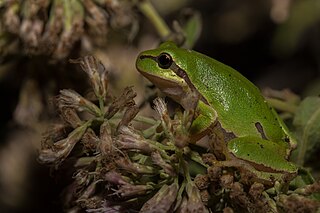
The European tree frog is a small tree frog. As traditionally defined, it was found throughout much of Europe, Asia and northern Africa, but based on molecular genetic and other data several populations formerly included in it are now recognized as separate species, limiting the true European tree frog to Europe from France to Poland and Greece.

The American green tree frog is a common arboreal species of New World tree frog belonging to the family Hylidae. This nocturnal insectivore is moderately sized and has a bright green to reddish-brown coloration. Commonly found in the central and southeastern United States, the frog lives in open canopy forests with permanent water sources and abundant vegetation. The American green tree frog is strictly aquatic during the hibernating and mating seasons. When defending its territory, the frog either emits aggressive call signals or resolves to grapple with intruders, seldom leading to injury or death. To avoid predation, the frog will leap into the water or jump into the treetops.
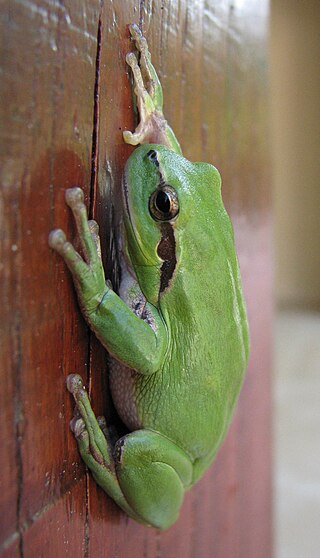
The Mediterranean tree frog, or stripeless tree frog, is a species of frog found in south-west Europe and north-west Africa. It resembles the European tree frog, but is larger, has longer hind legs, and the flank stripe only reaches to the front legs. The croaking resembles that of H. arborea, but it is deeper and slower.

The gray treefrog is a species of small arboreal holarctic tree frog native to much of the eastern United States and southeastern Canada.

The squirrel tree frog is a small species of tree frog found in the south-eastern United States, from Texas to Virginia. This is an introduced species in the Bahamas. Squirrel tree frogs are small frogs, about 1.5 inches in length as adults. There are several color variations, but most commonly they are green and look very much like the American green tree frog. They can also be varying shades of yellow or brown, sometimes with white or brown blotching.

Charadrahyla is a genus of frogs in the family Hylidae. It is endemic to tropical southern Mexico. The generic name was derived from Greek charadra ("ravine") and Hyla, in reference to the habits of these frogs. Accordingly, common name ravine treefrogs has been coined for the genus.

Dryophytes gratiosus, commonly known as the barking tree frog, is a species of tree frog endemic to the south-eastern United States. Formerly known as Hyla gratiosa.
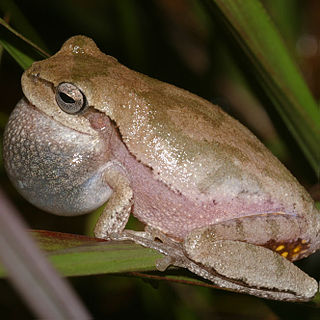
The pine woods tree frog is a species of frog in the family Hylidae, endemic to the southeastern United States.

Dryophytes immaculatus, the Chinese immaculate treefrog, is a species of frog in the family Hylidae endemic to China. The natural habitat of the species has been generally transformed into rice fields and it is threatened by habitat loss.

A tree frog is any species of frog that spends a major portion of its lifespan in trees, known as an arboreal state. Several lineages of frogs among the Neobatrachia suborder have given rise to treefrogs, although they are not closely related to each other.

Corethrellidae are a family of biting midges, small flying insects belonging to the order Diptera, females of which feed on the blood of frogs. The members of the family are sometimes known as frog-biting midges. The family currently consists of just one genus, totalling 115 extant and 10 fossil species worldwide. Most extant species are found in the lower latitudes, usually associated around the tropics.
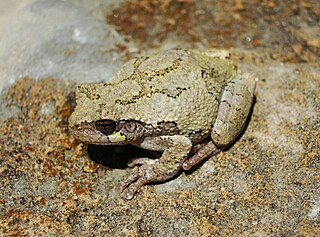
Dryophytes is a genus of Ameroasian tree frogs in the family Hylidae. They are found mostly in North America, but the genus also includes three species found in eastern Asia.
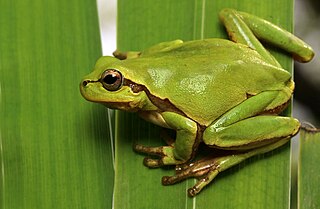
Hyla orientalis, also known by its common name eastern tree frog, is a species from the genus Hyla. The species was originally described by Jacques von Bedriaga in 1890, and is found in Asia Minor and southeastern Europe.
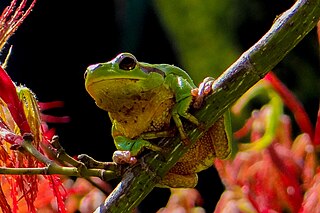
Hyla perrini, also known as Perrin's tree frog or Po's tree toad, is a species of frog in the family Hylidae. It is endemic to Europe. It is known from the Po Plain in northern Italy, and in adjacent Switzerland (Ticino) and Slovenia.

Dryophytes suweonensis, the Suweon treefrog or Suwon treefrog, is a species of frog in the family Hylidae endemic to the Korean Peninsula probably from the Imjin River to the Mangyeong River, south of Iksan. Its distribution and population have been assessed to be below 800 individuals and the status of the species has been updated as Endangered by the IUCN. The natural habitat of the species has been generally transformed into rice fields and it is threatened by habitat loss.
















